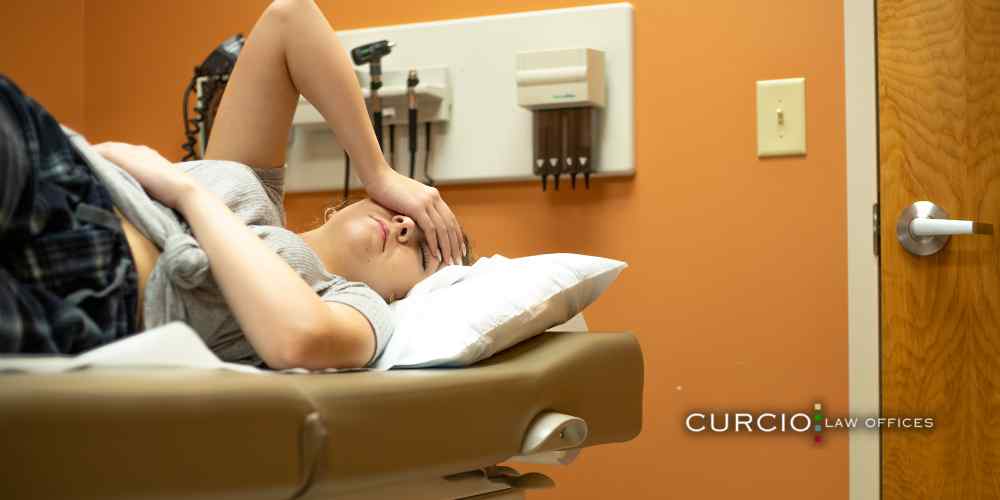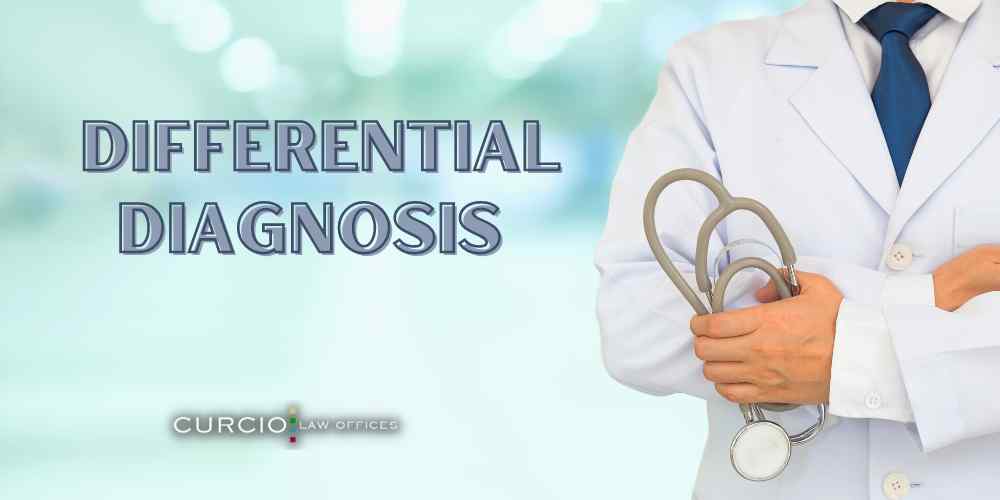In the realm of personal injury law, understanding the complexities of medical concepts is crucial, and one of the most important concepts to grasp is “differential diagnosis.” Differential diagnosis is one of many diagnostic methods that play a pivotal role in assessing and establishing the link between a person’s symptoms and a specific disease diagnosis.
It is basically a diagnostic process that creates a list of possible conditions to test for and treat based on a person’s symptoms. Using the differential diagnosis process is the best way to provide a correct diagnosis and treatment options. However, there is always room for error. It’s always possible for patients with major health conditions, like cancer, to walk away with a misdiagnosis and a potential death sentence. In such situations, the patient may have grounds to sue for medical malpractice.
At Curcio & Casciato, we recognize the significance of differential diagnoses and their impact on clinical decision-making. We also recognize how medical negligence can play a huge role in the entire diagnostic process, leading to an eventual misdiagnosis and fatal health conditions. Chicago medical malpractice attorneys at Curcio & Casciato want to fight for the justice of patients who received incorrect diagnoses due to negligence. We can protect your legal rights and help you recover a fair settlement. Call 312-321-1111 to schedule a free consultation today.
Differential Diagnosis Meaning

Differential diagnosis is a fundamental medical process used by healthcare professionals to determine the cause of a patient’s symptoms or condition. It involves systematically considering and ruling out various possible causes based on a person’s symptoms, diagnostic tests, medical history, and physical examination. The ultimate goal of differential diagnosis is to create a list of possible conditions that have overlapping symptoms and eventually narrow the list down to the most accurate and appropriate diagnosis among the many potential options.
Common Examples of Differential Diagnosis
Differential diagnosis is a versatile and widely used process in the medical field. It can be applied to various medical conditions that share the same symptoms. Some common examples of differential diagnoses include abdominal pain, chest pain, headache, depression, fatigue, and UTI.
Abdominal Pain
Abdominal pain can be caused by numerous factors, including gastrointestinal issues, appendicitis, kidney stones, trauma, or even digestive cancer. A primary care physician will use the differential diagnostic process to eventually come to a proper diagnosis and provide the right treatment.
Chest Pain
Chest pain can result from heart problems, respiratory issues like asthma, viruses like COVID-19, high blood pressure, muscle strain, or even severe anxiety and panic attacks. Differential diagnosis helps healthcare professionals identify the root cause of chest pain and provide appropriate treatment.
Headache
A wide range of factors, such as muscle tension, migraines, sinus infections, traumatic brain injuries, and prolonged psychological stress, can trigger headaches. A primary care physician can create a working diagnosis based on other symptoms, run lab tests and scans, and provide the best possible treatment.
Depression
Depression is a complex mental disorder with multiple potential causes, including genetic factors, life events, hormonal imbalances, and chemical imbalances in the brain. Differential diagnosis is essential to determine whether psychiatric symptoms are the root issue or another health condition (such as hypothyroidism, for example) is the root issue.
Based on the suspected diagnosis, an experienced doctor can determine the best way to treat and improve depression symptoms.
Fatigue
Fatigue is a common symptom that can be attributed to various underlying issues, such as sleep disorders, anemia, hormonal imbalances, mental disorders, chronic illnesses, or medication side effects. Differential diagnosis helps uncover the primary reason for fatigue and develop an effective treatment plan.
UTI
Urinary tract infection (UTI) can cause various symptoms, including urinary urgency, a painful burning sensation during urination, foul-smelling urine, and lower back pain. However, similar symptoms can also be caused by kidney stones, sexually transmitted infections, and interstitial cystitis.
A doctor will first run a series of diagnostic tests to determine if the patient has a bacterial infection in the urethra or bladder. It’s crucial to catch the infection quickly so it doesn’t spread to the kidneys. If the urine test comes back clear, the doctor will resort to the differential diagnostic process to eventually determine the root cause of the patient’s symptoms.
If your loved one has had ongoing medical history of UTIs in a nursing home and physicians didn’t conduct more than one physical examination or run diagnostic tests, contact our Chicago nursing home UTI lawyers for more information.
How Does the Differential Diagnostic Process Work?

The process of differential diagnosis is systematic and thorough. It involves asking questions about symptoms, reviewing patient history, performing a physical exam, creating a differential diagnosis list, reviewing test results and symptoms, and making a final diagnosis.
Asking Questions About Symptoms
The first step involves healthcare providers asking patients detailed questions about their symptoms. They inquire about the nature, onset, duration, and severity of symptoms and any factors that exacerbate or alleviate them.
Reviewing Medical History
A thorough review of the patient’s medical history and family history is essential. This includes information about pre-existing conditions, past illnesses, surgeries, medications, and family medical history of chronic conditions like cancer, for example. Identifying any relevant medical history is crucial for making an accurate diagnosis.
Performing a Physical Examination
A physical exam assesses the patient’s overall health and specific physical signs related to their symptoms. During this examination, healthcare providers may check vital signs (such as blood pressure and body temperature), inspect the affected area, and perform various laboratory examinations if necessary.
Creating a Differential Diagnosis
Based on the information gathered from questioning, reviewing medical history, and conducting a physical examination, healthcare providers compile a list of potential diagnoses. This list represents all possible causes of the patient’s symptoms.
Usually, the first condition on the differential diagnosis list has the highest likelihood of being the root cause of the patient’s symptoms, while the last condition on the list has the lowest likelihood of being the root cause of the patient’s symptoms.
Reviewing Test Results and Symptoms
Diagnostic and laboratory tests, such as blood tests, biopsies, or imaging tests (i.e., magnetic resonance imaging, CT scans, X-rays) may be ordered to gather additional information. Test results are carefully reviewed to eliminate some potential diagnoses from the list and further refine the differential diagnosis. The doctor will run additional tests if none of the other results help narrow down underlying conditions.
Making a Final Diagnosis
Once all relevant information has been collected and analyzed, healthcare providers make a final diagnosis by selecting the most likely cause of the patient’s symptoms. This diagnosis guides treatment and further evaluation, if necessary.
What Do the Results of Differential Diagnosis Mean?
The differential diagnostic process is not your final diagnosis in and of itself; it is merely a list of the conditions or injuries that share the same symptoms that you have.
This list contains all the most probable explanations of your symptoms based on your doctor’s initial clinical examination. The goal is to eventually narrow this list to the right diagnosis through diagnostic tests and exams and then develop a treatment plan.
The result of the differential diagnostic process is your final diagnosis, based on all the tests and exams your doctor has conducted.
Differential Diagnoses: The Risks

While differential diagnosis is a valuable and widely accepted diagnostic process, it has risks and challenges. Some of the risk factors associated with differential diagnosis include:
Misdiagnosis
Despite the systematic approach, healthcare providers can still make errors in the differential diagnosis process, leading to a misdiagnosis. A misdiagnosis can result in incorrect treatment and potentially worsen a patient’s condition. Chicago cancer misdiagnosis attorneys can help victims seek justice and fair compensation.
Delay in Treatment
The thorough nature of differential diagnosis can sometimes lead to delays in treatment, especially if further tests are needed to confirm the diagnosis. In some cases, immediate medical attention is critical, and delays can have serious consequences.
Overdiagnosis or Underdiagnosis
Healthcare providers may occasionally over-diagnose or under-diagnose a condition, leading to unnecessary treatments or missed opportunities for effective treatment.
Complex Cases
Some highly complex medical conditions may not fit neatly into a single diagnosis. Healthcare providers may need to consider multiple possible causes, complicating the process.
Differential Diagnosis vs. Misdiagnosis
Differential diagnosis is a structured and systematic approach to diagnosing medical conditions to minimize the risk of misdiagnosis. A misdiagnosis occurs when a healthcare provider makes an incorrect diagnosis. While misdiagnosis can happen despite the best efforts of medical professionals, it is a distinct issue from differential diagnosis.
Differential diagnosis, when performed correctly, involves considering multiple potential diagnoses and systematically eliminating less likely options to arrive at the most accurate diagnosis. In contrast, misdiagnosis arises from errors, biases, or insufficient information that lead to an incorrect conclusion.
In personal injury cases, distinguishing between differential diagnosis and misdiagnosis becomes crucial. If a plaintiff’s injuries are misdiagnosed or overlooked due to medical negligence, it can significantly impact the outcome of a personal injury claim.
Can You Sue for Diagnostic Errors?
When a diagnostic error, such as a cancer misdiagnosis, for example, occurs due to medical negligence and results in harm or worsened medical conditions, it may warrant a medical malpractice lawsuit. Medical malpractice claims arise when healthcare providers fail to meet the standard of care expected in their profession, resulting in harm to the patient. In the context of diagnostic errors, patients can potentially sue for damages if certain criteria are met.
How to Prove Negligence in a Misdiagnosis Claim
If your doctor failed to provide you with the correct diagnosis and treatment for your condition, and you suffered serious physical, emotional, or financial harm as a result, you may have grounds to take legal action.
Medical malpractice claims are very complex due to the complexities of the medical field. You will need an experienced medical malpractice attorney and an experienced medical expert on your side. Together, your attorney and the medical expert can carefully review the details of your case and help you prove the 4 D’s of negligence.
Duty of Care
In a medical malpractice case, the plaintiff (the injured patient) must establish that the healthcare provider owed them a duty of care. This duty of care means that the healthcare provider is responsible for providing competent and appropriate medical care to the patient.
Breached Duty of Care
To pursue a medical malpractice claim, the plaintiff must also demonstrate that the healthcare provider breached their duty of care. In the case of misdiagnosis or diagnostic errors, this typically involves showing that the healthcare provider did not follow standard medical practices, made errors in the diagnostic process, or failed to consider relevant information.
Causation
Proving causation is a critical element in a medical malpractice claim. The plaintiff must demonstrate that the healthcare provider’s breach of duty directly caused harm. In the context of diagnostic errors, this means showing that the misdiagnosis or delayed diagnosis resulted in worsened medical conditions or unnecessary harm.
Damages
Lastly, the plaintiff must provide evidence of damages caused by the misdiagnosis or diagnostic error. These damages can include medical expenses, pain and suffering, lost wages, and any other losses incurred due to medical negligence.
Damages for Diagnostic Errors
When pursuing a medical malpractice claim related to diagnostic errors, two primary categories of damages may be sought: economic and non-economic.
Economic Damages
Economic damages refer to the tangible financial losses incurred due to the misdiagnosis or diagnostic error. These can include:
- Medical Expenses: The costs associated with additional medical treatments, surgeries, medications, and therapies necessitated by the misdiagnosis.
- Lost Income: If the patient could not work or experienced a reduced earning capacity due to the diagnostic error, they may be entitled to compensation for lost wages and future earning potential.
- Rehabilitation Costs: Expenses related to rehabilitation or long-term care needed because of the diagnostic error.
Non-Economic Damages
Non-economic damages are more subjective and relate to the intangible losses experienced by the patient, such as pain and suffering, emotional distress, permanent illness or disability, and a diminished quality of life. In cases of severe misdiagnosis, where the patient’s condition worsens due to delayed or incorrect treatment, non-economic damages can be substantial.
These damages are often more challenging to quantify but can significantly impact a patient’s life and well-being. An experienced medical malpractice attorney at Curcio & Casciato can help you accurately calculate the amount of damages you deserve from a negligent doctor and fight for justice.
Call Chicago Medical Malpractice Lawyers at Curcio & Casciato Today
Navigating the complex terrain of medical malpractice claims, especially those involving diagnostic errors or misdiagnoses, can be daunting. At Curcio & Casciato, we have a team of experienced medical malpractice attorneys who understand the intricacies of these cases. If you or a loved one has suffered harm due to a diagnostic error or misdiagnosis, we are here to help.
Our Chicago-based medical malpractice lawyers are dedicated to advocating for your rights and pursuing the compensation you deserve. We will thoroughly investigate your case, work with medical experts to assess the extent of the harm caused, and diligently represent you in negotiations or court.
Remember that time is of the essence in medical malpractice cases, as there are Illinois medical malpractice statute of limitations that restrict the time frame within which you can file a lawsuit. Don’t hesitate to contact Curcio & Casciato for a free consultation to discuss your case. Our commitment to justice and our clients is unwavering, and we are here to provide you with the legal support and guidance you need during this challenging time.
Contact Curcio & Casciato today at 312-321-1111 and let us help you seek justice and compensation for the harm you have suffered due to a diagnostic error or misdiagnosis. Your well-being is our priority, and we are ready to fight for your legal rights.



